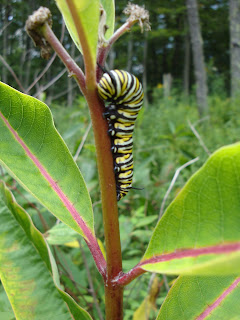The butterfly is a flying flower,
The flower a tethered butterfly.
Pounce Denis Ecouchard Lebrum
The amazing and wonderful Monarch Butterfly is probably best known for it's migration. While the lifespan of monarchs born in early summer is less than two months, the last generation of the summer enters into a non-reproductive phase called diapause and may live to seven or more months. It migrates to the winter site and does not reproduce until it leaves this area in February.
This is a male monarch which can be determined by the two raised spots on the hind wings. The spots are actually pouches that release pheromones to attract females. However, the female monarch can be distinguished by the wider veins on the wings and the darker color when in flight.
The monarch caterpillar goes through five stages called instars. As the caterpillar grows, it becomes too big for its skin, molts, and eats the old skin. This is one of the later instars.
Just as orange means caution to us, scientists believe that the bright colors serve as a warning to enemies of this butterfly. Monarchs are poisonous or at least distasteful to birds and mammals because of substances derived from the milkweeds on which it feeds.
Another beautiful golden butterfly is the fritillairy. In West Virginia, we have a number of different ones including the Great Spangled Fritillary. The scientific name is Speyeria cybele. Cybele means "mountain mother" or "earth mother". In late summer the female will lay as many as 2000 eggs on or near violets. In the fall, the eggs hatch, but the caterpillars go to sleep without eating and wake in the spring when they begin to feed on the young violet plants. Scientists are researching to see if global warming might change the timing and thus the result could be devastating for the hungry caterpillars.
This picture of a fritillary taken earlier in the summer plainly shows the spots on the under wing. Appalachian folklore claims that if you catch the butterfly and count the spots, that is how much money you will come into. It's easy to imagine children of earlier times enjoying this fantasy.
This aging and battered butterfly is called a Buckeye. Like its cousin the Monarch, it migrates south for the winter.
A pretty, but tiny butterfly is this Pearl Crescent sitting on a Brown-Eyed Susan. The female lays her eggs on asters. Its wingspan is only 1.25 to 1.5 inches. Look closely or you may not see it.
Something about the underside of this butterfly makes it seem grotesque. Possibly it's because the rotten pear that it is eating, just doesn't seem that appealing. Supposedly, they will even get a bit tipsy from eating fermented fruit which results in their erratic flight.
When it opens it wings, the surprise is to see a beautiful and colorful butterfly called a Red Admiral. These butterflies are said to be both territorial and attracted to perspiration. If you are lucky, they will land on your shoulder.
This fuzzy little butterfly almost has a teddy bear like quality to its head. It is a skipper, and unlike other butterflies, it holds its wings separately when puddling as can be seen in the picture below.
This white butterfly looks so dainty against the purple asters. Unfortunately, it is the dreaded cabbage butterfly that is a plague to gardeners. The species came to North America from Europe around the time of the Civil War. The two spots on the upper wing of this one indicate that it is a female. Males have only one spot.
Finally, we have the regal Eastern Tiger Swallowtail. The female may look like the one below or even be dark like the Pipevine Swallowtail. An interesting fact about this species is that when the caterpillar first hatches, it is camouflaged to look like bird poop.
"Just living is not enough" said the butterfly, "one must have sunshine, freedom and a little flower." Hans Christian Anderson
This is a good message for all of us.














No comments:
Post a Comment